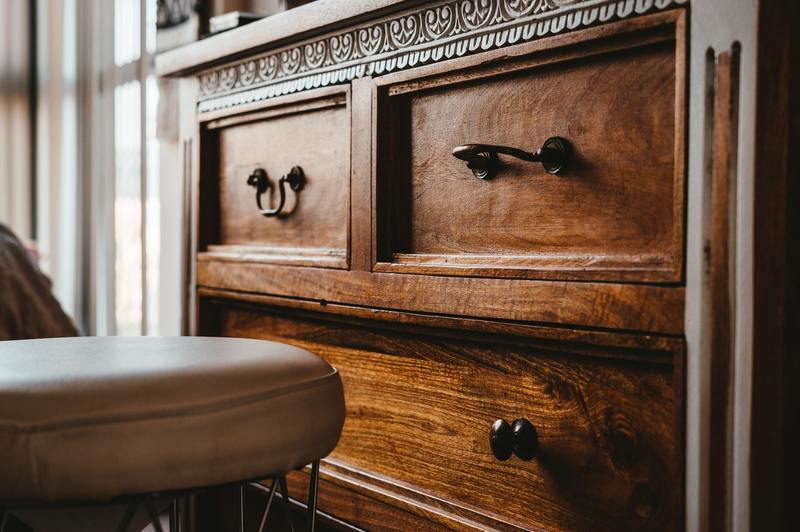Learning how to repair water damaged wood dresser is a skill that you’ll never know you might need. Imagine you purchased a new wood dresser or bargained an old one, it will be susceptible to many sorts of breakdowns. Well, wood can deteriorate mainly when left unattended to moisture and rain.
Whether it is indoor flooding, or a heavy rain heaped the place, wood dressers can absorb water which causes it to bloat. The best thing to say is that you need to get rid of the water. Understand that there are many kinds of wood, and we will walk you through how to restore it!

What Does Water Do To Wood Dressers?
If you are a construction worker, interior design specialist, or a houseperson, you know that water damage is a pretty common problem. When water comes in contact with wood, miniature holes inside the wood seeps liquid in.
Most often contaminated water joins the party, so fungus, and other microorganisms can barge in too. Sometimes, even termites can infest the dressers.
Note that there are different types of wood. Typically, the plywood type is used for furniture.
This is made of different textures of wood, so when it gets wet it will crumble easily. On the other hand, hardwood can withstand harsh humidity. While innovative wood polishes are created to prevent moisture from coming in, this natural material is still vulnerable to rundowns.
Key Steps On How To Redevelop Water Damaged Wood Dresser
Step #1. Let water completely evaporate
Water is not a viscous substance therefore it can just keep on streaming. If water is trapped deep into the furniture however, it might be more difficult for it to dry. We call it the 24-hour contact period, which tells us how long it was exposed to wet sources.
We recommend that you move the wood dresser to an area where it can access air. Leaving it under the sun would be great. Water stains can destroy its foundation, and that is why it is important to let all water evaporate.
Step #2. Examine gunk build-up
Rain is not just the classic H2O combo — it also consists of other things as germs, bugs, or even molds. According to Anthony Woodward, water droplets originate from water vapor which also comes from salt, soot, and dust accumulation. Raindrops will release chemicals when they meet the surface.
It’s not exactly pleasant to come searching for fungi and other dirty things. On a good note, if you already assessed that there is a gunk build-up then you are one step closer to restoring a water damaged wood dresser.
Step #3. Take out any rundown wood
Now, we will embark into some real handywork. You will need your hammer and your crowbar ready. Any ruined wood is not aesthetically pleasing nor will help the beautification of the dresser.
You should spot those soft and crumbly parts of the material. Those parts scream the sign of wood decay, which can be home for little termites. Soft parts also say that there is secondary water damage.
If you thought you already let the dresser sundry, you might want to check again. It’s better to carve out those parts as well.
Step #4. Do the necessary repairs
Your primary tools and equipment need more buddies! Industrial glue, putty, and wood fillers are a bunch of those. Once gunk and water have been steered out of the way, you can proceed to do the strengthening.
Raise the wood dresser to a semi-elevated area. This way you won’t hurt your back when doing the touch-ups. If a part of the wood is too ruined to keep, replace it immediately.
Next up, it is best to make use of the industrial reinforcements. After the dresser is strengthened at its endpoints, mind the cracks on the wood. These will make the wood vulnerable to water damage all over again, so fillers could make a big difference.
Step #5. Paint on furniture polish
This step is by far the best time to bring out the meticulousness in you. Furniture polish is a mixture of resin and oils that protects the outer layer of the wood dresser.
Varnish is the first thing to counter weather conditions, scratches, and ultimately against water. Bring out your old paint brush and start applying a thin layer over the surface. You want to do it all in one go so that the varnish can stand long periods.
Can You Still Salvage An Extremely Submerged Wood Furniture?
Strictly speaking, if the furniture has suffered more than 90% damage, it is time to say goodbye to it. However, if it is lower than that, then you will be able to save it. After all, you saved up money to buy a wood dresser, and you wouldn’t want it to be destroyed in such an unexpected manner.
Conclusion
Wood dressers can store clean garments and are sturdy overall. Perhaps the best way to prevent water damage is to not expose it to humidity, right?
However, unfortunate occurrences sometimes happen. That’s why we want you to know how to repair water damaged wood dresser.
